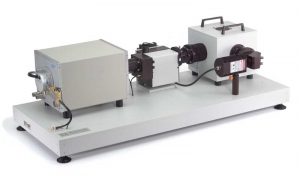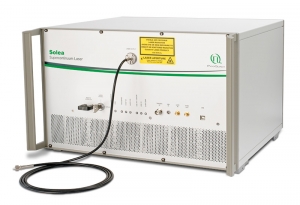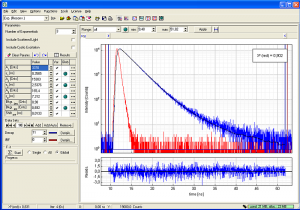Fluorescence Spectrometers
FluoTime 200 (discontinued)
Modular Fluorescence Lifetime Spectrometer
- Modular and flexible design
- Picosecond temporal resolution
- Time-Correlated Single Photon Counting (TCSPC) and Multi-Channel Scaling (MCS)
- Low temporal dispersion monochromator
- High quality polarizers
- Advanced data analysis software
The FluoTime 200 is discontinued as of April 2020.
The FluoTime 200 spectrometer is a high performance fluorescence lifetime system featuring modular construction, single photon timing sensitivity and research flexibility. It contains the complete optics and electronics for recording fluorescence decays by means of Time-Correlated Single Photon Counting (TCSPC) and/or Multi-Channel Scaling (MCS). The system is optimized for high temporal resolution and can be used with femtosecond or picosecond lasers, like the picosecond diode lasers from PicoQuant. With the FluoTime 200, decay times down to a few picoseconds can be resolved. The system allows operation at laser repetition rates as high as 100 MHz and count rates up to several million counts/sec.
Laser coupling module
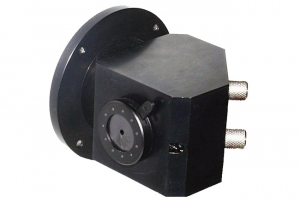 The laser coupling module consists of an iris, a beam steering mirror, an optional replaceable polarizer module and a focusing lens. The iris allows precise adjustment of the excitation intensity and prevents the penetration of room light into the sample chamber. The beam is directed towards the sample by an adjustable steering mirror. An optional Glan-Thompson prism polarizer selects the desired polarization plane of the non-polarized radiation. The beam is finally focused onto the sample by an adjustable lens.
The laser coupling module consists of an iris, a beam steering mirror, an optional replaceable polarizer module and a focusing lens. The iris allows precise adjustment of the excitation intensity and prevents the penetration of room light into the sample chamber. The beam is directed towards the sample by an adjustable steering mirror. An optional Glan-Thompson prism polarizer selects the desired polarization plane of the non-polarized radiation. The beam is finally focused onto the sample by an adjustable lens.
Versatile sample chamber
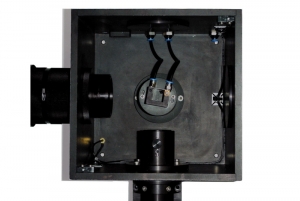 The sample chamber contains a versatile sample holder (standard: cuvette, optional: front face) and a mechanism to protect the detector from excessive light exposition. Temperature control of the cuvette holder is possible by attaching an external thermostat (tubing for the circulating fluid is pre-installed) or by replacing the standard cuvette holder with a peltier-cooled holder. Later upgrades to T- or X-geometry are possible.
The sample chamber contains a versatile sample holder (standard: cuvette, optional: front face) and a mechanism to protect the detector from excessive light exposition. Temperature control of the cuvette holder is possible by attaching an external thermostat (tubing for the circulating fluid is pre-installed) or by replacing the standard cuvette holder with a peltier-cooled holder. Later upgrades to T- or X-geometry are possible.
Compact monochromator
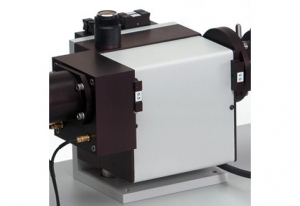 For spectral filtering of the emitted light, a small monochromator is chosen, featuring low temporal dispersion, high throughput and low stray light level. This Seya-Namioka type monochromator has 100 mm focal length and an aperture of f/3.2. The standard configuration contain a 32 mm × 32 mm aberration corrected concave holographic grating with 1200 lines/mm, blazed at 450 nm. The spectral (linear) dispersion is 8 nm/mm. The delivered set of interchangeable slits with 0.5, 1.0 and 2.0 mm width therefore provide 4, 8 and 16 nm spectral bandwidth, respectively. Other gratings are available upon request.
For spectral filtering of the emitted light, a small monochromator is chosen, featuring low temporal dispersion, high throughput and low stray light level. This Seya-Namioka type monochromator has 100 mm focal length and an aperture of f/3.2. The standard configuration contain a 32 mm × 32 mm aberration corrected concave holographic grating with 1200 lines/mm, blazed at 450 nm. The spectral (linear) dispersion is 8 nm/mm. The delivered set of interchangeable slits with 0.5, 1.0 and 2.0 mm width therefore provide 4, 8 and 16 nm spectral bandwidth, respectively. Other gratings are available upon request.
Several available detector types
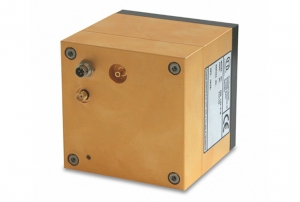 The FluoTime 200 uses single photon counting detectors of various types, attached to an exit slit of the emission monochromator. The available detectors are either photomultiplier tubes (PMA Series or NIR-PMTs), Hybrid-PMT modules (PMA Hybrid Series) or Microchannel Plate Photomultiplier Tubes (MCP-PMTs). The detectors offer picosecond temporal resolutions and cover different spectral ranges between 180 nm and 1700 nm. Each detector includes an electro-mechanical shutter and can optionally be cooled.
The FluoTime 200 uses single photon counting detectors of various types, attached to an exit slit of the emission monochromator. The available detectors are either photomultiplier tubes (PMA Series or NIR-PMTs), Hybrid-PMT modules (PMA Hybrid Series) or Microchannel Plate Photomultiplier Tubes (MCP-PMTs). The detectors offer picosecond temporal resolutions and cover different spectral ranges between 180 nm and 1700 nm. Each detector includes an electro-mechanical shutter and can optionally be cooled.
TCSPC data acquisition
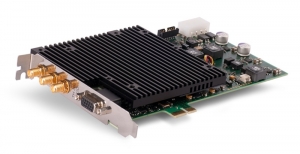 Two outstanding Time-Correlated Single Photon Counting (TCSPC) data acquisition units are available for the FluoTime 200. The TimeHarp 260 is the perfect choice for systems equipped with a detector of the PMA Series or PMA Hybrid Series. Along with a dedicated "long range mode", the TimeHarp 260 can be used to resolve fluorescence lifetimes in the range of several ten picoseconds and several seconds. The PicoHarp 300 offers an even better temporal resolution and is therefore recommended for FluoTime 200 systems equipped with a MCP-PMT detector. In that case even fluorescence lifetimes of a few picoseconds can be resoved along with suited excitation sources.
Two outstanding Time-Correlated Single Photon Counting (TCSPC) data acquisition units are available for the FluoTime 200. The TimeHarp 260 is the perfect choice for systems equipped with a detector of the PMA Series or PMA Hybrid Series. Along with a dedicated "long range mode", the TimeHarp 260 can be used to resolve fluorescence lifetimes in the range of several ten picoseconds and several seconds. The PicoHarp 300 offers an even better temporal resolution and is therefore recommended for FluoTime 200 systems equipped with a MCP-PMT detector. In that case even fluorescence lifetimes of a few picoseconds can be resoved along with suited excitation sources.
Advanced data analysis
 Measurement data can be directly transferred to the established FluoFit software for decay analysis. The FluoFit software features global decay analysis with an easy-to-use graphical user interface and presentation-ready numerical and graphical output. It implements an iterative reconvolution fitting routine with nonlinear error minimization. Various exponential decay models (up to fourth order) or rate constant distribution models can be fitted to the observed decay in order to determine the fluorescence lifetime(s) or to study fluorescence anisotropy, along with rigorous error analysy methods.
Measurement data can be directly transferred to the established FluoFit software for decay analysis. The FluoFit software features global decay analysis with an easy-to-use graphical user interface and presentation-ready numerical and graphical output. It implements an iterative reconvolution fitting routine with nonlinear error minimization. Various exponential decay models (up to fourth order) or rate constant distribution models can be fitted to the observed decay in order to determine the fluorescence lifetime(s) or to study fluorescence anisotropy, along with rigorous error analysy methods.
Course on time-resolved fluorescence
 PicoQuant annually holds the European short course on "Principles and Applications of Time-resolved Fluorescence Spectroscopy". The course is intended for individuals wishing an in-depth introduction to the principles of fluorescence spectroscopy and its applications to the Life Sciences. The course is held in cooperation with Prof. J.R. Lakowicz from the Center of Fluorescence Spectroscopy (CFS) in Baltimore and consists of lectures as well as instrumentation and software hands-on training. For details see the course website.
PicoQuant annually holds the European short course on "Principles and Applications of Time-resolved Fluorescence Spectroscopy". The course is intended for individuals wishing an in-depth introduction to the principles of fluorescence spectroscopy and its applications to the Life Sciences. The course is held in cooperation with Prof. J.R. Lakowicz from the Center of Fluorescence Spectroscopy (CFS) in Baltimore and consists of lectures as well as instrumentation and software hands-on training. For details see the course website.
The FluoTime 200 is discontinued as of April 2020.
Detailed specifications are included in the datasheet.
| Optical configuration |
|
| Mode of operation |
|
| Lifetime range |
|
| Excitation sources |
|
| Monochromators |
|
| Detectors |
|
| Software |
|
All Information given here is reliable to our best knowledge. However, no responsibility is assumed for possible inaccuracies or omissions. Specifications and external appearances are subject to change without notice.
The FluoTime 200 is discontinued as of April 2020.
Double subtractive monochromator
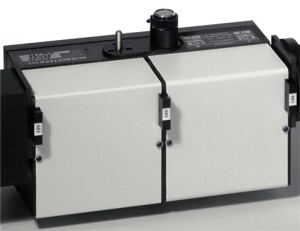 Systems with MCP-PMT detectors and ultrafast excitation sources can exploit the advantages of the Sciencetech 9030DS. In this double subtractive monochromator, the two gratings operate in a subtractive dispersion mode. The first monochromator selects a bandpass and the second monochromator then removes the temporal and angular aberrations (dispersions). The result is superior stray light rejection and ultimate time resolution.
Systems with MCP-PMT detectors and ultrafast excitation sources can exploit the advantages of the Sciencetech 9030DS. In this double subtractive monochromator, the two gratings operate in a subtractive dispersion mode. The first monochromator selects a bandpass and the second monochromator then removes the temporal and angular aberrations (dispersions). The result is superior stray light rejection and ultimate time resolution.
NIR-PMT detector
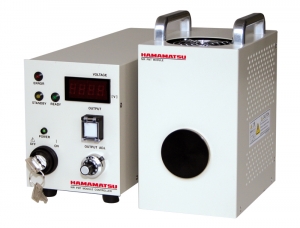 These special photomultipliers are suitable for single photon counting in the NIR. The H10330-45 features an InGaAsP photocathode and is sensitive in the wavelength range from 950 nm to 1400 nm. The H10330-75 variant has an InGaAs photocathode and its sensitivity range is extended to 1700 nm. The module has a thermally insulated sealed-off housing evacuated to a high vacuum. No liquid nitrogen, vacuum pumps nor water cooling is necessary.
These special photomultipliers are suitable for single photon counting in the NIR. The H10330-45 features an InGaAsP photocathode and is sensitive in the wavelength range from 950 nm to 1400 nm. The H10330-75 variant has an InGaAs photocathode and its sensitivity range is extended to 1700 nm. The module has a thermally insulated sealed-off housing evacuated to a high vacuum. No liquid nitrogen, vacuum pumps nor water cooling is necessary.
MCP-PMT detector
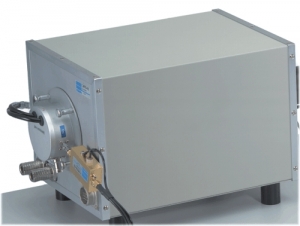 These are the fastest photon counting detectors today. Various photocathode materials cover the wavelength range from 160 nm to 910 nm. Using this detector and Ti:Sapphire laser excitation, instrument response functions as short as 32 ps were achieved with the FluoTime 200. The modules have a dedicated high voltage power supply. Optionally, they can be mounted into a thermoelectrically cooled housing. In this case, water cooling is necessary.
These are the fastest photon counting detectors today. Various photocathode materials cover the wavelength range from 160 nm to 910 nm. Using this detector and Ti:Sapphire laser excitation, instrument response functions as short as 32 ps were achieved with the FluoTime 200. The modules have a dedicated high voltage power supply. Optionally, they can be mounted into a thermoelectrically cooled housing. In this case, water cooling is necessary.
Xenon flashlamp
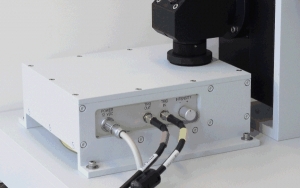 The xenon flashlamp emits approximately 400 ns broad flashes at up to 300 Hz repetition rate, ideal for investigation of slow luminescence decays, like phosphorescence or lanthanide emission. A dedicated ScienceTech 9030 monochromator is used to select the desired excitation wavelength from the broad xenon emission spectrum. The lamp requires only 12V power and an external trigger signal. The latter can be generated by e.g. the TimeHarp 260 NANO multiscaler board, which is typically used in connection with the flashlamp.
The xenon flashlamp emits approximately 400 ns broad flashes at up to 300 Hz repetition rate, ideal for investigation of slow luminescence decays, like phosphorescence or lanthanide emission. A dedicated ScienceTech 9030 monochromator is used to select the desired excitation wavelength from the broad xenon emission spectrum. The lamp requires only 12V power and an external trigger signal. The latter can be generated by e.g. the TimeHarp 260 NANO multiscaler board, which is typically used in connection with the flashlamp.
Liquid nitrogen cryostat
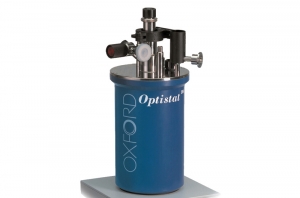 The sample chamber is large enough to accommodate an Oxford Instruments OptistatDN series cryostat. This optional component allows low temperature photoluminescence measurements to be made. Precise control of the sample temperature is possible with various cryostat types from 2.3 K to 500 K. A stand-alone digital cryostat controller is included.
The sample chamber is large enough to accommodate an Oxford Instruments OptistatDN series cryostat. This optional component allows low temperature photoluminescence measurements to be made. Precise control of the sample temperature is possible with various cryostat types from 2.3 K to 500 K. A stand-alone digital cryostat controller is included.
Glan-Taylor polarizers
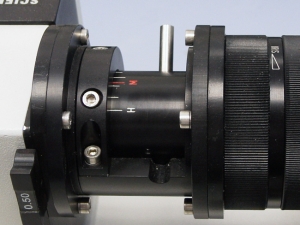 Glan-Taylor polarizers can be optionally mounted in the emission arm as well as in the excitation arm. These polarizers feature a spectral range of 250 nm - 2700 nm at a very high contrast. The horizontal, vertical and magic angle conditions are clearly marked on the mounts. Mounting and unmounting of the polarizers can easily be done at any time.
Glan-Taylor polarizers can be optionally mounted in the emission arm as well as in the excitation arm. These polarizers feature a spectral range of 250 nm - 2700 nm at a very high contrast. The horizontal, vertical and magic angle conditions are clearly marked on the mounts. Mounting and unmounting of the polarizers can easily be done at any time.
Sample holders
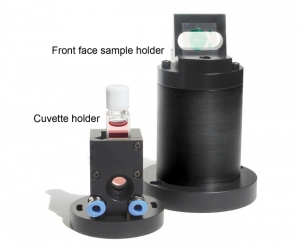 The FluoTime 200 can be equipped with a cuvette holder and a front face sample holder. The standard cuvette holder is designed for 1 cm × 1 cm path length cuvettes and is also prepared for a water circulation system with easily accessible water inlets. As an alternative a front face sample holder can be mounted to investigate solid samples. Other types of sample holders can be also be used upon special request.
The FluoTime 200 can be equipped with a cuvette holder and a front face sample holder. The standard cuvette holder is designed for 1 cm × 1 cm path length cuvettes and is also prepared for a water circulation system with easily accessible water inlets. As an alternative a front face sample holder can be mounted to investigate solid samples. Other types of sample holders can be also be used upon special request.
Peltier cooled sample holder
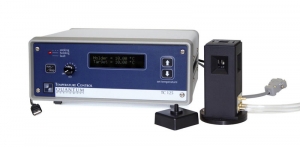 The FluoTime 200 can be equipped with a peltier cooled cuvette holder with integrated magnetic stirrer from Quantum Northwest. The holder is designed for 1 cm × 1 cm path length cuvettes. The temperature can bet set between approx. -50°C and +100°C using an external control unit or alternatively be programmed via a dedicated software and USB interface.
The FluoTime 200 can be equipped with a peltier cooled cuvette holder with integrated magnetic stirrer from Quantum Northwest. The holder is designed for 1 cm × 1 cm path length cuvettes. The temperature can bet set between approx. -50°C and +100°C using an external control unit or alternatively be programmed via a dedicated software and USB interface.
Rapid Kinetic (Stopped-Flow) Accessories
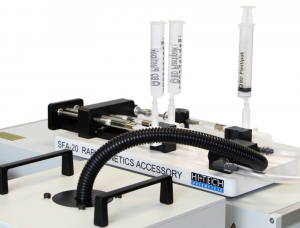 Rapid kinetic accessories (SFA-20 series) from TgK Scientific Ltd. make possible to monitor fast reactions (on millisecond time scale) in solution, like enzyme kinetics, quenching, association/dissociation, etc. The accessory has an empirical deadtime <8 ms. Microvolume version, pneumatic drive, anaerobic kit, variable ratio mixing, multi-mixing versions and advanced analysis software (Kinetic Studio) are available as options.
Rapid kinetic accessories (SFA-20 series) from TgK Scientific Ltd. make possible to monitor fast reactions (on millisecond time scale) in solution, like enzyme kinetics, quenching, association/dissociation, etc. The accessory has an empirical deadtime <8 ms. Microvolume version, pneumatic drive, anaerobic kit, variable ratio mixing, multi-mixing versions and advanced analysis software (Kinetic Studio) are available as options.
Multipass cell
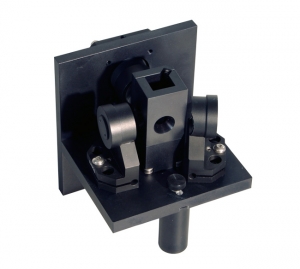 For very low emission intensities, the FluoTime 200 can be equipped with a multipass cell to increase the effective excitation volume and hence the signal strength. Two mirrors next to the cuvette holder are used to reflect the excitation beam several times through the sample. These multi-excitations lead to a broader overall instrument response function, which means that the multipass cell is best suited for long lived decays (phosphorescence).
For very low emission intensities, the FluoTime 200 can be equipped with a multipass cell to increase the effective excitation volume and hence the signal strength. Two mirrors next to the cuvette holder are used to reflect the excitation beam several times through the sample. These multi-excitations lead to a broader overall instrument response function, which means that the multipass cell is best suited for long lived decays (phosphorescence).
The FluoTime 200 is discontinued as of April 2020.
FluoPlot - a software to analyse Time-Resolved Emission Spectra
In time-resolved fluorescence research, it is often of great interest to observe time-dependent spectral shifts and decay changes in the context of solvent relaxation dynamics and general spectral evolution. This requires recording Time-Resolved Emission Spectra (TRES), ideally with automated wavelength scan and TCSPC data collection under full software control.
In order to measure emission spectra in combination with fluorescence lifetime, the FluoTime 200 data acquisition software provides an automated TRES measurement mode. This mode allows to control a monochromator via a stepper motor and automated collection of spectrally resolved lifetime histograms.
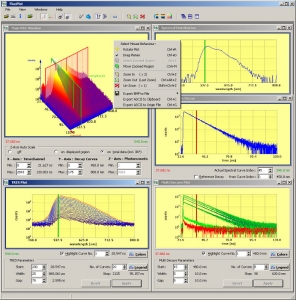 For the analysis of these measurements, the Fluoplot software is provided with the system. It is designed to support your work in respect of analysis, illustration and documentation and in providing many useful graphics and data import and export facilities. It also interfaces with the fluorescence decay analysis package FluoFit. Intuitive navigation and convenient control by mouse or keyboard will let you feel familiar after a short time of customization.
For the analysis of these measurements, the Fluoplot software is provided with the system. It is designed to support your work in respect of analysis, illustration and documentation and in providing many useful graphics and data import and export facilities. It also interfaces with the fluorescence decay analysis package FluoFit. Intuitive navigation and convenient control by mouse or keyboard will let you feel familiar after a short time of customization.
The FluoPlot software includes many useful functions and visualisation tools, such as
- 3D visualisation of the measured decay with free 3D rotation capabilities, adjustable color scale, different projection styles and various export functions
- 2D visualisation of the measured decays
- Adjustable 2D cuts through the 3D visualisation for
- Emission spectrum as a function of decay time
- Fluorescence decay as a function of emission wavelength
- Interval analysis of TRES measurements: combining multiple time or wavelength channels to achieve higher statistics; definition and display of multiple intervals
- Spectral correction of wavelength data
- Export of all data to ASCII
The FluoTime 200 is discontinued as of April 2020.
L-Tryptophane dissolved in water
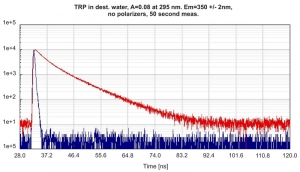 A solution of L-Tryptophane in water (HPLC quality) was excited at 300 nm. The collected emission passed a monochromator set to 350 nm with 4 nm bandpass. The measured instrument response function (IRF) has a FWHM of 600 ps and 1.5 million counts were collected within 50 seconds measurement time. No polarizers were used in the set-up.
A solution of L-Tryptophane in water (HPLC quality) was excited at 300 nm. The collected emission passed a monochromator set to 350 nm with 4 nm bandpass. The measured instrument response function (IRF) has a FWHM of 600 ps and 1.5 million counts were collected within 50 seconds measurement time. No polarizers were used in the set-up.
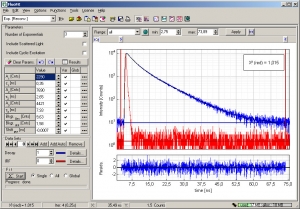 As can be expected for L-Tryptophane the decay is best described by a triple exponential decay funciton. The picture shows the IRF (red), the measured decay (blue) and the result of the fit (black). The recovered lifetimes are 0.35 ± 0.18 ns , 2.65 ± 0.1 ns and 7,93 ± 0.1 ns. The errors were calculated using the support plane analysis.
As can be expected for L-Tryptophane the decay is best described by a triple exponential decay funciton. The picture shows the IRF (red), the measured decay (blue) and the result of the fit (black). The recovered lifetimes are 0.35 ± 0.18 ns , 2.65 ± 0.1 ns and 7,93 ± 0.1 ns. The errors were calculated using the support plane analysis.
Set-up:
- FluoTime 200
- Excitation: PLS 300, 10 MHz repetition rate
- Analysis: FluoFit
NATA in water
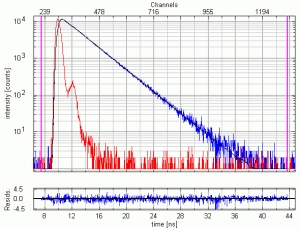 10 µM NATA (N-acetyl-L-tryptophanamide) dissolved in water excited at 280 nm. The fluorescence emission at 350 nm was detected through an f/3.2 monochromator set to 16 nm bandpass. 1.3 million counts were collected within 60 seconds, corresponding to an average detection rate of 21.7 kHz, i.e. less than 1% of the excitation rate thereby avoiding pulse pileup effects. The measured instrument response function (IRF) has a FWHM of 700 ps. The picture shows the IRF (red), the decay (blue) and the fitted single exponential curve (black). The fitted lifetime is 2.88 ns and the reduced chi-square = 1.065. The quality of the results can be also judged by the residual distribution plotted at the bottom.
10 µM NATA (N-acetyl-L-tryptophanamide) dissolved in water excited at 280 nm. The fluorescence emission at 350 nm was detected through an f/3.2 monochromator set to 16 nm bandpass. 1.3 million counts were collected within 60 seconds, corresponding to an average detection rate of 21.7 kHz, i.e. less than 1% of the excitation rate thereby avoiding pulse pileup effects. The measured instrument response function (IRF) has a FWHM of 700 ps. The picture shows the IRF (red), the decay (blue) and the fitted single exponential curve (black). The fitted lifetime is 2.88 ns and the reduced chi-square = 1.065. The quality of the results can be also judged by the residual distribution plotted at the bottom.
Set-up:
- FluoTime 200
- Excitation: PLS 280, 2.5 MHz repetition rate
- Analysis: FluoFit
Apomyoglobin in buffer
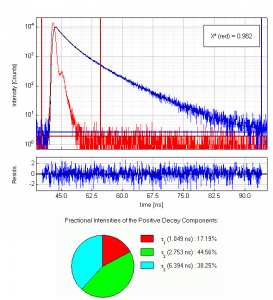 Full length apomyoglobin has 154 amino acids including two tryptophans and three tyrosines. A 5 µM solution of this protein in acetate buffer was excited at 280 nm. Glan-Taylor polarisers where used in order to select the vertically polarized component of the excitation light and the magic-angle polarized component of the fluorescence. The collected emission passed a monochromator set to 350 nm with 30 nm bandpass. The measured instrument response function (IRF) has a FWHM of 700 ps and 1.2 million counts were collected within 4 minutes measurement time. The analysis of the measurement results showed that in this case the decay is best described by a triple exponential decay funciton. The picture shows the IRF (red), the measured decay (blue) and the result of the fit (black) along with the three recovered lifetimes and their fractional intensities.
Full length apomyoglobin has 154 amino acids including two tryptophans and three tyrosines. A 5 µM solution of this protein in acetate buffer was excited at 280 nm. Glan-Taylor polarisers where used in order to select the vertically polarized component of the excitation light and the magic-angle polarized component of the fluorescence. The collected emission passed a monochromator set to 350 nm with 30 nm bandpass. The measured instrument response function (IRF) has a FWHM of 700 ps and 1.2 million counts were collected within 4 minutes measurement time. The analysis of the measurement results showed that in this case the decay is best described by a triple exponential decay funciton. The picture shows the IRF (red), the measured decay (blue) and the result of the fit (black) along with the three recovered lifetimes and their fractional intensities.
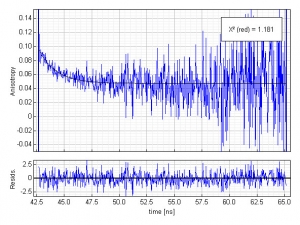 Further information about the protein dynamics can be obtained by a quick anisotropy decay analysis. Two more histograms were collected, the so called parallel and perpendicular polarized decays. The simplest anisotropy analysis involves a direct calculation of the anisotropy decay curve R(t) from those polarized decays. The necessary G-factor was determined in an independent decay measurement with horizontally polarized excitation.The picture shows the time evolution of the anisotropy (blue) during the first 20 ns and a fitted single exponential decay curve (black). The time resolved anisotropy reveals an average rotational correlation time of 1.6 ns and a residual anisotropy of 0.05. This residual anisotropy is a clear indication of a slower process, which cannot be resolved using the fluorescence of tyrosine and tryptophane as an indicator. In fact, the expected rotational correlation time of apomyoglobin is in the order of 7-8 ns and this process is most likely the reason for the residual anisotropy.
Further information about the protein dynamics can be obtained by a quick anisotropy decay analysis. Two more histograms were collected, the so called parallel and perpendicular polarized decays. The simplest anisotropy analysis involves a direct calculation of the anisotropy decay curve R(t) from those polarized decays. The necessary G-factor was determined in an independent decay measurement with horizontally polarized excitation.The picture shows the time evolution of the anisotropy (blue) during the first 20 ns and a fitted single exponential decay curve (black). The time resolved anisotropy reveals an average rotational correlation time of 1.6 ns and a residual anisotropy of 0.05. This residual anisotropy is a clear indication of a slower process, which cannot be resolved using the fluorescence of tyrosine and tryptophane as an indicator. In fact, the expected rotational correlation time of apomyoglobin is in the order of 7-8 ns and this process is most likely the reason for the residual anisotropy.
Set-up:
- FluoTime 200
- Excitation: PLS 280, 2.5 MHz repetition rate
- Analysis: FluoFit
The FluoTime 200 is discontinued as of April 2020.
p>The FluoTime 200 is a modular fluorescence lifetime spectrometer. It can be used to study various samples and perform several applications, including:
- Time-Resolved Fluorescence
- Singlet Oxygen
- Time-Resolved Photoluminescence (TRPL)
- Fluorescence Anisotropy (Polarization)
- Photochemistry
The FluoTime 200 is discontinued as of April 2020.
The following documents are available for download:
Latest 10 publications referencing FluoTime 200
The following list is an extract of 10 recent publications from our bibliography that either bear reference or are releated to this product in some way. Do you miss your publication? If yes, we will be happy to include it in our bibliography. Please send an e-mail to info@picoquant.com containing the appropriate citation. Thank you very much in advance for your kind co-operation.



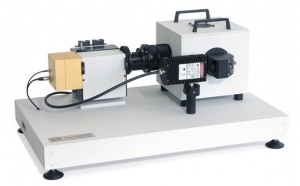
 Get in touch
Get in touch
